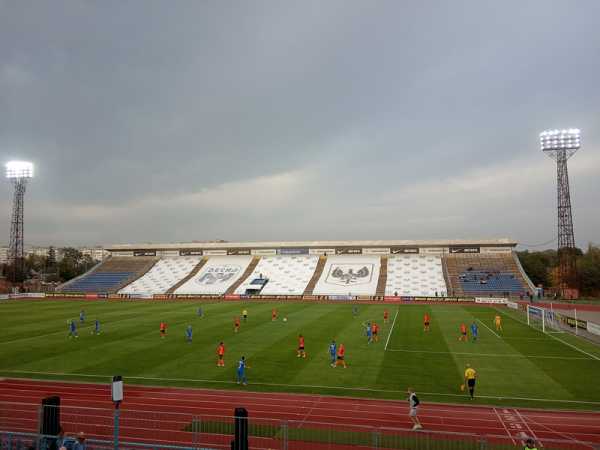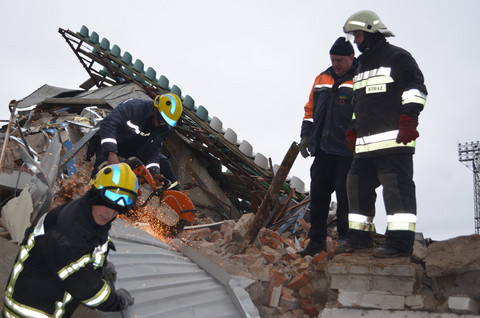
The Chernihiv Stadium of Desna Chernihi, in northern Ukraine, also known as the Yuri Gagarin Stadium was destroyed during the siege of the city (Photo: Wikimedia)
On 18 October 2023, Russian artillery hit and damaged the pitch of Stadion Torpedo in Zaporizhzhia. However, this stadium was not the only one to suffer severe damage in the wake of the conflict.
During the early stages of the conflict in Donbas in 2014, two major stadiums in Donetsk and Luhansk Oblasts suffered damage. Avanhard Stadium in Luhansk, constructed in 1951 with a capacity of 22,000, served as the home ground for Zorya Luhansk and was struck by mortars in July 2014.
-

Workmen search through the rubble of the Gagarin stadium (Photo: Wikimedia)
Donbas Arena in Donetsk, previously used by Shakhtar Donetsk and one of the eight stadiums used in EURO 2012 hosted by Poland and Ukraine, was built in 2009 and is one of Ukraine’s largest stadiums, accommodating 52,000 spectators. It suffered artillery shelling in 2014.
Due to the conflict in Eastern Ukraine, both Shakhtar Donetsk and Zorya Luhansk had to play matches in other parts of the country.
Eight years later, in 2022, Russia launched an invasion of Ukraine. The Battle of Mariupol commenced on February 24th, 2022, the first day of the invasion, resulting in the destruction of the city situated in the Donetsk Oblast. The Volodymyr Boyko Stadium, formerly used by the Ukrainian Premier League club FC Mariupol, suffered significant damage. Similarly, in 2023, Bakhmut experienced extensive destruction, with the Metalurh Stadium used by FC Bakhmut being shelled in April 2023.
In Southern Ukraine, Kherson was the first major city to fall to Russian forces. The Krystal Stadium, built in 1962 with a capacity of 3,400, which hosted FC Krystal Kherson, was also damaged. Furthermore, to the west of Kherson, in June 2022, Mykolaiv was targeted by major Russian missiles. As a result, the field of the Tsentralnyi Stadion, which was used by local teams FC Vast Mykolaiv and MFC Mykolaiv, suffered significant damage.
In northern Ukraine, as Russian forces attempted to encircle the Ukrainian capital Kyiv during the initial stages of the invasion, Champion Stadium in Irpin and Mykhailo Brukvenka Stadium in Makariv, located in Kyiv Oblast, were also damaged. In August 2022, Ukrainian football legend Andriy Shevchenko visited the Champion Stadium in Irpin, where he played as a child, and together with United24, initiated a fundraiser for the stadium’s reconstruction.
Also in the north, the Chernihiv Stadium of Desna Chernihiv, also known as the Yuri Gagarin Stadium, was destroyed during the siege of the city. The Chernihiv Arena, used by FC Chernihiv, was also targeted and bombed.
The Metalist Stadium, another EURO 2012 venue and the former home ground of FC Metalist Kharkiv suffered damage during the Battle of Kharkiv. The Sonyachny Stadium, a training ground for the Ukrainian National Football Team, also experienced shelling. The Sonyachny Stadium was the home ground for Helios Kharkiv and Metalist 1925 Kharkiv.
Arena Lviv, which has a seating capacity of 34,900, served as the home ground for both FC Lviv and Rukh Lviv. However, during the conflict, it transformed into a vital refugee coordination centre and emergency shelter for 2,000 to 3,000 individuals. Situated just 90 kilometers away from the Polish border and experiencing comparatively less damage than cities in western Ukraine, Lviv emerged as a significant refugee hub throughout the war.
On June 6th, 2023, the Kakhovka Dam on the Dnieper River was damaged which triggered widespread flooding across cities and towns in the Kherson Oblast. In the Russian-occupied section of the Kherson Oblast, two stadiums, namely Stadion Enerhiya in Nova Kakhovka and Stadion “Start” in Oleshky, were submerged underwater.
Stadion Enerhiya was previously used by the Ukrainian Second League (Druha Liha) club, FC Enerhiya Nova Kakhovka, which was disbanded in 2022 following the Russian invasion. Stadion “Start” served as the home ground for FK Voskhod, a Ukrainian Women’s League club based in Stara Mayachka.
Amidst the conflict in Ukraine, numerous cultural heritage sites were lost. According to UNESCO reports, 334 cultural sites, including religious buildings, museums, historical structures, monuments, and libraries, were damaged. Additionally, thousands of educational institutions were affected by the war.
The dire situation of Ukraine’s stadiums, damaged or destroyed during the conflict, while not as important as the human cost of the war, highlight the country’s sporting heritage. It is disheartening to witness the transformation of these football grounds, which once showcased the beauty of the sport, into battlefields.
Source: euobserver.com



